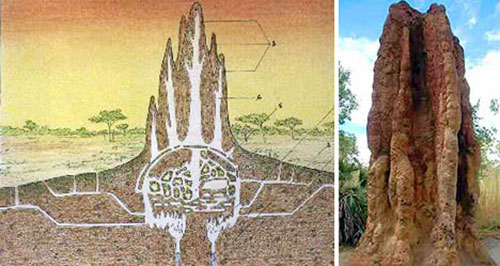Experience building from termites
In the middle of the vast African grassland, there is a model 'environmentally friendly' city. The towers are built entirely of biological materials, easily decomposing in nature. Residents of the city live in cool areas and have ideal humidity without spending 1 watt of electricity. This is not a science fiction thing but a fact about a 'city' of . termites.
When the issues of climate change become urgent, more and more experts in biology and architecture . are more concerned with the 'master' method of building, according to New Scientist experts. In the past, there were a number of scientists interested in this issue but their research results have not been widely disseminated and applied. Swiss entomologist Martin Luscher began to study the architecture of termite clusters of the Macrotermes genus since the 1960s. He realized that the way to build is directly related to the term's eating habits . The main food of this insect is fiber (cellulose) from wood, which is difficult to digest. Termites have 'grown' some special fungi that are able to convert this 'difficult to swallow' food into easily absorbed nutrients. However, the 'cultivating' environment must be cool and at appropriate humidity, something that is not simple for tropical African climates. Termites are required to have an extremely efficient gas exchange system.

Termites are masters of environmentally friendly architecture - Photo: Tdrinc
According to expert Scott Turner of New York University (USA), the outer walls of the termite are built so that only slow winds can "creep" inside. Thus, in termites, emissions and fresh air are constantly moving, ensuring gas exchange process. In other words, special architecture helps termites act as a giant lung.
In addition, we know how to change how to build a nest to adapt to the environment. For example, in an overheated environment, these talented 'architects' will 'bury' the nest deeper into the ground, effectively controlling temperature. In order to keep the moisture, they will line the bottom of the nest with a layer of wood and the grass is chewed and mixed together. This mixture will act as a 'super sponge', which can suck in or 'release' up to 80 liters of water to balance the moisture in the nest. These are certainly useful lessons for people to go to 'ecological' cities in the future, Mr. Turner said.
- The digestive apparatus of the term acts as a biofuel refinery
- Essence is 'better than wood'
- Decode the genetic genome of the termite
- It took nearly 100 years for scientists to identify termites belonging to cockroach relatives
- Termites, the solution to the global energy?
- Termites have grown mushrooms 7 million years ago
- Termite is a species of social cockroach
- Camera detects cancer, termites
- Mushrooms and termites - Symbiotic relationship
- Detecting termites can perform spawning without males
- Human experience when it comes to death
- Strangely the building was built upside-down in Spain
 'Fine laughs' - Scary and painful torture in ancient times
'Fine laughs' - Scary and painful torture in ancient times The sequence of numbers 142857 of the Egyptian pyramids is known as the strangest number in the world - Why?
The sequence of numbers 142857 of the Egyptian pyramids is known as the strangest number in the world - Why? Miracle behind the world's largest stone Buddha statue
Miracle behind the world's largest stone Buddha statue What is alum?
What is alum?